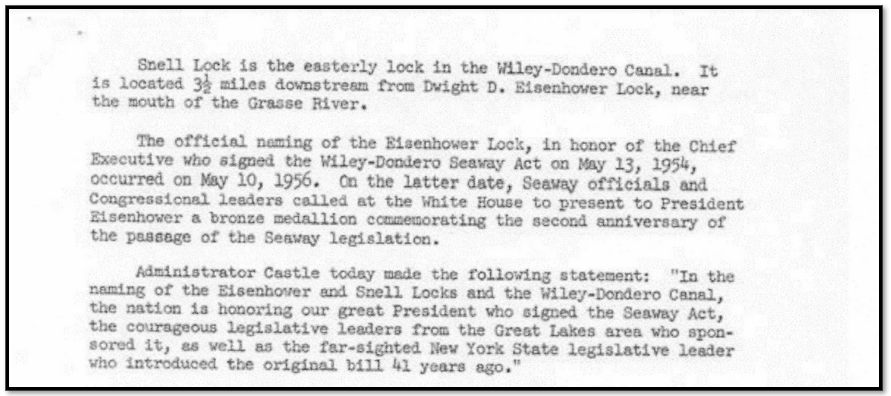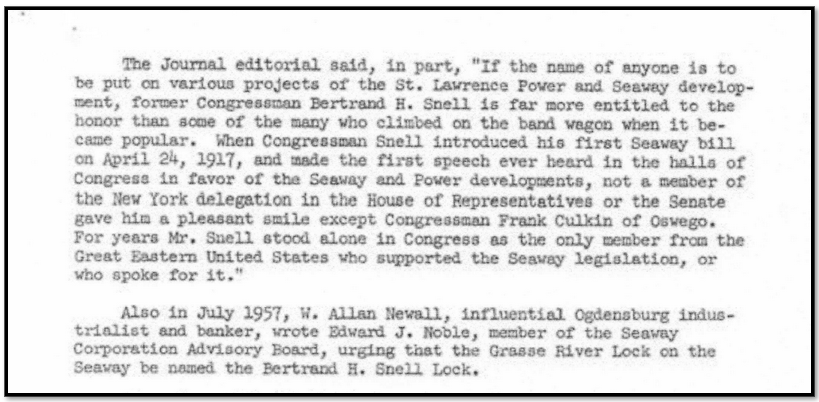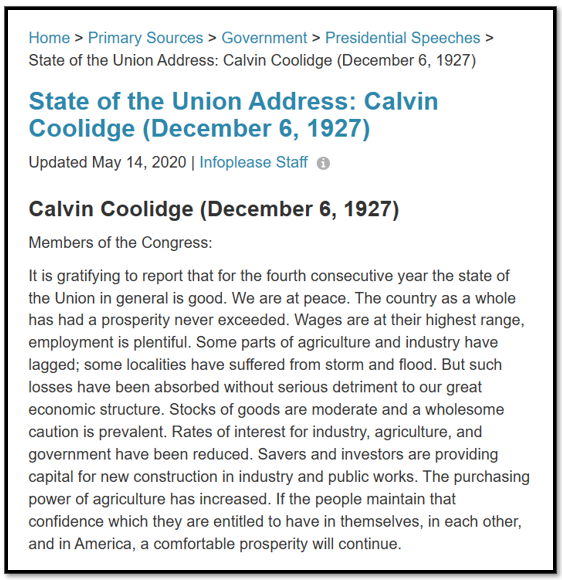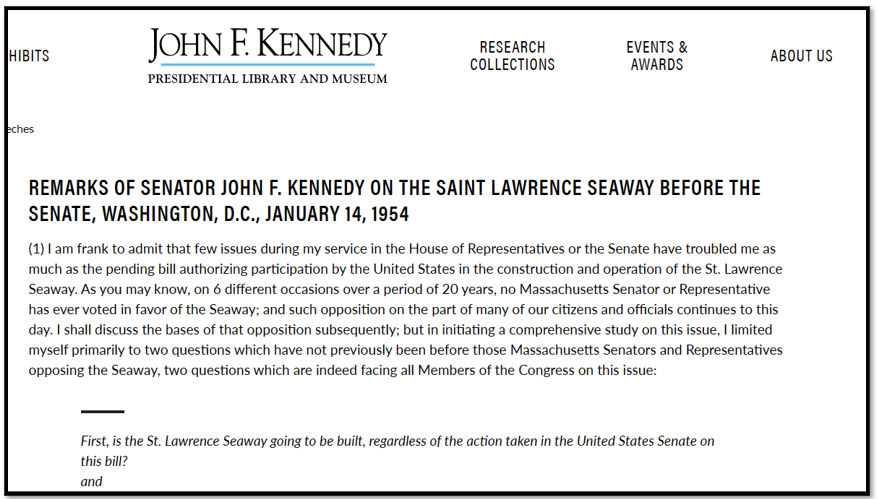Here are Two New Names Deserving of Recognition
Residents on both sides of the border in the Thousand Islands will note a few milestones when the Montreal-Lake Ontario section of the St. Lawrence Seaway opens for business in a few days. The 2024 navigation season is scheduled to start on March 22 at 8 am, when Massena’s Snell and Eisenhower locks will awaken the international maritime trade route from Montreal to the Great Lakes from winter hibernation.
This year marks the 70th anniversary of President Eisenhower’s January 7, 1954 “State of the Union” message to Congress in which he told the Senate and House:
“This Nation is at last to have an up-to-date mobilization base – the foundation of a sound defense program . . . Part of this foundation is . . . our continental transport system. Some of our vital heavy materials come increasingly from Canada. Indeed, our relations with Canada, happily always close, involves more and more the unbreakable ties of strategic interdependence. Both nations now need the St. Lawrence Seaway for security as well as for economic reasons. I urge the Congress promptly to approve our participation in its construction.”
On May 13th of that year, Eisenhower signed legislation bringing the United States into participation with Canada in the construction of the Seaway. Five years later, the President and Queen Elizabeth II officially opened the Seaway and the Royal Yacht Britannia introduced the Thousand Islands to the world as something other than a salad dressing.

This year will mark the 65th opening of the Seaway. The Massena locks bear the names of two Seaway heroes – President Eisenhower, because he signed the 1954 legislation, and Bertrand H. Snell of Potsdam in St. Lawrence County, a man who had a distinguished career in Congress. He was elected to the House of Representatives from Northern New York in 1914 and became the senior leader of House Republicans from 1931 until his retirement in 1938. During that career he introduced the first Seaway-Power Development bill on April 24, 1917!
The ten mile Wiley-Dondero canal connecting the US locks bears the names of two more heroes – US Senator Alexander Wiley, a Republican from Wisconsin, and Representative George A. Dondero, a Republican from Michigan – both Seaway port states – who introduced the bills signed into law by President Eisenhower. They were longtime Seaway advocates. Eisenhower, Snell, Wiley, and Dondero were designated “Fathers of Seaway” in 1958, by the US Seaway Development Corporation.

The concept of a waterway linking the Atlantic Ocean to the Great Lakes had generated serious interest as early as the 1800s, but it took Bertrand Snell to bring it alive. Throughout the ensuing decades, it faced fierce competition from Atlantic, Pacific, and Gulf ports, joining the 300 railroads making up the strong lobbying Association of American Railroads, which feared that opening Great Lakes ports to the international markets would bring a significant negative impact to their prosperity. The ports’ Representatives, Senators, Governors, and stakeholders joined forces to oppose any such construction. Their combined lobbying strength overwhelmed and far outweighed the dreams of Seaway proponents.
But two other major supporters have been forgotten – President Calvin Coolidge and then-Senator John F. Kennedy also played important roles in seeking Congressional approval for US Seaway construction, nearly three decades apart.
In his State of the Union address to Congress on December 6, 1927, the 30th President of the United States, Calvin Coolidge, became an early hero when he told the members of the House and Senate:
“The Congress in its last session authorized the general improvements necessary to provide the Mississippi waterway system with better transportation. Stabilization of the levels of the Great Lakes and their opening to the sea by an effective shipway remain to be considered. Since the last session, the Board of Engineers of the War Department has made a report on the proposal for a canal through the State of New York, and the Joint Board of Engineers, representing Canada and the United States, has finished a report on the St. Lawrence River.”
“Both of these boards conclude that the St. Lawrence project is cheaper, affords a more expeditious method of placing western products in European markets, and will cost less to operate. The State Department has requested the Canadian Government to negotiate treaties necessary to provide for this improvement. It will also be necessary to secure an agreement with Canada to put in works necessary to prevent fluctuation in the levels of the Great Lakes.”

Summary of remarks by SENATOR JOHN F. KENNEDY before the Senate, supporting US participation in Seaway construction with Canada, January 14, 1954 (six years before he became President):
“I cannot oppose the Seaway because the direct economic benefits will go largely to the Great Lakes and Middle Western areas. I could not conscientiously take such a position, and at the same time expect support from the Senators in the Middle West or any other part of the country for those programs and projects of aid to New England.”
“The Seaway is going to be built; the only question is the part we shall play in opening our fourth coastline. To those in my state and elsewhere, who oppose our participation in the construction of this project for national security merely because the economic benefits go elsewhere, I would say that it has been this arbitrary refusal of many New Englanders to recognize the legitimate needs and aspirations of other sections, which has contributed to the neglect of, and even opposition to, the needs of our own region by the representatives of other areas. We cannot continue so narrow and destructive a position. As was so well stated by a famous Massachusetts Senator over 100 years ago, our aim should not be "States dissevered, discordant, (or) belligerent"; but "One country, one Constitution, one destiny."

Fast Forward to a Recent Request
Recent request made to US Secretary of Transportation, Pete Buttigieg, and US Seaway Administrator Adam Tindall-Schlicht:
As noted above, President Calvin Coolidge and then Senator John F. Kennedy played key roles in promoting the Seaway when their voices were needed the most. Their contributions were never recognized by your predecessors. How about putting their names on a recognition plaque for display at the impressive new Visitors Center at Eisenhower Lock in Massena? Signed, Respectfully, Cary Brick.

The Seaway Today
The Seaway has lived up to the expectations of its earliest proponents by becoming a major commercial worldwide shipping route. Since 1959, more than 2.5 billion tons of cargo estimated at $375 billion have moved to and from Canada, the United States, and nearly fifty other nations. Seaway traffic travels regularly to and from Europe, the Middle East, and Africa.
2023 marked the longest scheduled shipping season in its history, when the Montreal-Lake Ontario section closed on January 5, 2024. During the winter, both Seaway entities continued in annual multi-million-dollar winter maintenance and infrastructure renewal programs.
In January, the Canadian St. Lawrence Seaway Management Corporation (SLSMC) and U.S. Great Lakes St. Lawrence Seaway Development Corporation (GLS) announced that nearly 38 million tons of cargo had transited the binational system in 2023, representing an overall increase of more than 3.4 percent. Great Lakes and Seaway commerce plays a key role in supporting 246,000 jobs and $36 billion in economic development activities across North America.
By Cary R. Brick
Cary Brick is a retired 30 year Congressional Chief of Staff, who worked with three successive Members of Congress representing the New York congressional District that borders the length of the international section of the Seaway from Massena to Lake Ontario. He is a frequent contributor to Thousand Islands Life.
Posted in: Volume 19, Issue 3, March 2024, Essay
Please click here if you are unable to post your comment.
